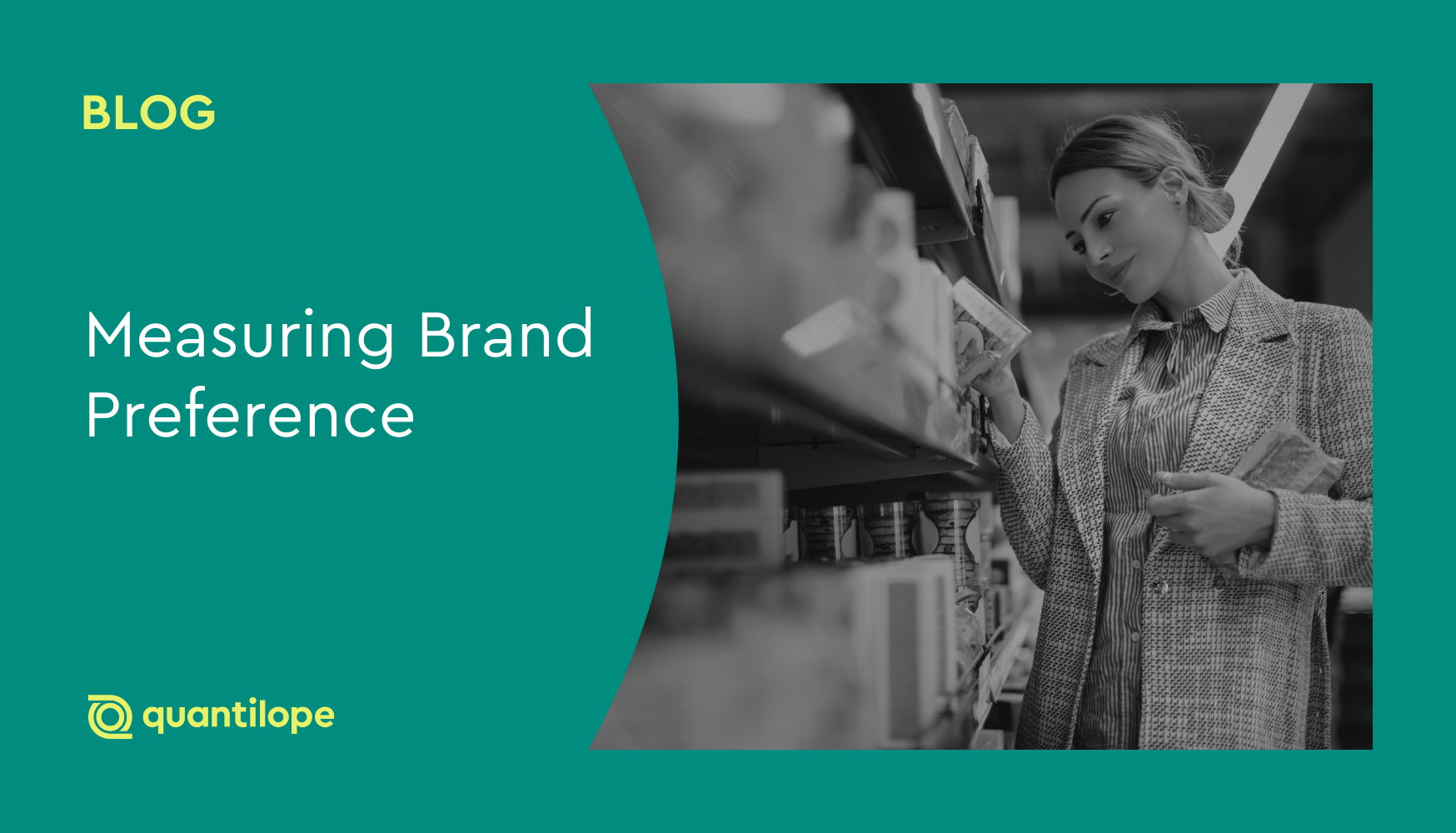In this blog post, learn what an insights platform is, when your company should consider adopting one, and how quantilope can arm your brand with valuable qualitative insights.
Table of Contents:
- What are qualitative insights?
- How does qualitative research help create great customer experiences?
- How to gather qualitative insights to improve the customer experience
-
How quantilope can arm you with valuable qualitative insights
What are qualitative insights?
Qualitative research has a unique and powerful role in the market research world; its value lies in the depth it can achieve by exploring topics in a loosely structured way. As its name suggests, qualitative research examines the quality of people's opinions and feelings, while quantitative research quantifies those opinions, telling you what proportion of your respondents feel a certain way.
In contrast to quantitative research, qualitative research takes a relatively small number of respondents. Rather than asking this group of participants to complete a survey with limited answer options, qualitative methods ask them to talk about a variety of issues using open-ended questions. It is designed in such a way that respondents are given the opportunity to talk freely within a loose framework or, with the most unstructured qualitative approaches, set their own agenda completely.
Qualitative data cannot be shown in bar charts or graphs as there are no numbers to measure. The raw material in qual is verbatim quotes, which can be analyzed and organized into a collection of themes. The quotes themselves are used to illustrate the findings, which is particularly powerful if the research has been filmed.
How does qualitative research help create great customer experiences?
Qualitative research can be used at any point in the research process, depending on what you want it to do for you.
Below are a few uses cases in which you might want to leverage this research approach:
- At the start of a study, to establish what the issues are that need to be included and measured in subsequent quant research
- After quantitative data collection, to explore the opinions behind the metrics in more depth - the why beyond the what? - or to explore the thoughts of a subset of people that the quant has revealed as a potential target
- As a standalone study, if you already have an idea of what your target audience thinks and want to understand the nuances of their thoughts. Or, if the research includes an experiential element that makes qual particularly suited to it (e.g. handling packaging, observing consumer behavior, understanding a shopper's journey throughout a store).
Qualitative insights are invaluable for informing business strategy and tactical planning because they bring your business closer to the customer. Hearing customers speak will not only help you gear your offer to their mindset and desires by filling their needs gaps but also do so in a way that resonates with them. When you hear the language they use to describe their needs, their feelings, and their ideal laundry detergent (or whatever the product might be), you can play this language back to them in your communication so that they immediately understand your offer is relevant to them.
Qualitative research also excels at revealing how consumers say something as well as what they say. Body language, tone of voice, and facial expressions are all key insights that add an extra layer of understanding to expressed opinions - and assess whether what consumers say is what they really feel.
There is something very compelling about seeing and hearing from real people; bringing insights to life via quotes and videos creates very memorable research for your internal business audience. As you're probably gathering, qual research has applications across the board. Whenever you want to hear from people in their own words, qual can help.
Here are some examples:
Branding:
Exploratory work around the marketplace and competitive landscape help organizations understand how their brand is viewed and experienced 'on the ground'. Exercises could include grouping different brands into subsets according to whatever criteria respondents naturally apply.
For example, if you're a luxury fashion brand you might want to know how you fare compared to competitors; seeing respondents map brands can be particularly insightful - and in-depth questioning will reveal why certain brands sit together in one 'family' while others are perceived to be different.
Drilling down into exactly what defines your brand - perhaps using qual techniques such as personification ('if this brand were a person, what would he/she look like or act like, what would their job be, what would they do in their spare time?', etc.) - creates a vivid representation of your brand to understand its role in people's lives.
Understanding consumer behavior:
Qualitative research is fantastic for not only hearing from consumers but also observing them. Much of human behavior is subconscious, so often consumers will say they do one thing but actually do another - or they might be unaware of some of their behavior altogether.
Any research objectives that require knowledge of how consumers behave while researching, purchasing, or using a product or service are well-served by qual. For example, if you accompany a shopper around a grocery store as they do their weekly shopping, their behavior will be very different from when they are popping in for a handful of items. Their behavior will vary greatly depending on the category they are shopping for, and the factors they take into account as they make their purchase decisions provide rich consumer insights to feed into store layout, shelf layout, signage, store ambiance, pricing, and even the positioning of the grocery brand itself.
Measuring the impact of marketing activities:
With qualitative research, you can witness the awareness levels and reactions to marketing activities by placing consumers in the relevant environment and exposing them to the marketing messages you're researching. For example, asking respondents to record their experience at a sports event will help brands understand how impactful advertising is; observing them as they browse a website will reveal whether they look at or click on any ads; seeing their trip to a restaurant will gain insight into the effects of marketing communication at the table, at the point of ordering or at any other location in the venue.
Beyond awareness, in-depth exploration of advertising executions and messages is another qual research strength. Gaining reactions in respondents' own words helps guide brands in developing advertising routes that strike a chord with consumers and optimize purchase intent. With packaging, qualitative research helps uncover which routes work best and why - be it the material, design, layout, graphics, colors, or on-package information.
Finding new business opportunities
Some research requires gathering new ideas and spotting the potential for expanding a current offer or creating new ones. The open-ended nature of qual is perfect for hearing from consumers about their lifestyle, their needs, their frustrations, and their preferences - all of which give clues as to what would improve their lives. A breakfast solution that you can eat on the go? A family mobile phone bundle? Discovering those potential areas for product development arises from really getting inside the heads of your target consumers and listening to how they feel about their world.
How to gather qualitative insights to improve the customer experience
How you gather qualitative insights really depends on the subject of your research and its objectives.
The main qualitative methodologies each have their own strengths:
Focus groups
Great for debate, discussion, brainstorming, and building upon new ideas, focus groups comprised of five to eight people maximize creativity. They are a good way to test whether an idea 'has legs', while contrasting and conflicting opinions between respondents reveal sticking points and the varying perceptions that need to be considered.
Depth interviews
Interviews with one person (or a pair if there is a need to understand the dynamics between two people - e.g. a couple's purchase decision-making process) help drill down to the fundamental views and preferences that underlie an individual's approach to anything. Depth interviews are particularly useful when wanting to understand a decision journey, or when interviewing an expert in a certain field (e.g. doctors, opinion leaders).
Ethnographic approaches
Witnessing the behavior of interest in an authentic setting can be invaluable for truly seeing a business issue through the consumer's eyes. For automotive research, sitting in the car with a respondent as they drive will reveal the importance of factors like comfort, tech, and dashboard layout; spending time in the home with someone as they use your product reveals how it is used in situations, what works well, and what could be improved. Watching TV or browsing the internet with a respondent brings insights around not only how they react to media, but the circumstances and mood they are in when they use it, which can be vital information to have when gearing your offer to them.
Online qualitative research
Online qual methodologies range from virtual focus groups and interviews to a whole new suite of methodologies and qualitative analysis tools that make the most of technology advancements (such as sentiment analysis).
The most successful online qual platforms manage to combine the best elements of in-person research with the flexibility and freedom of online tools. This ranges from one-off videos filmed by the respondent in their own time to diary-style studies that are more longitudinal in nature. Including tasks for respondents to film, or simply asking them to film specific aspects of their daily life make online qual particularly suited to ethnographical approaches.
How quantilope can arm you with valuable qualitative insights
inColor, quantilope's online video research platform, is multifaceted, versatile, and instinctive to use. Without having to leave your desk, inColor enables you to see respondents answering video research questions in depth so that you come away with truly actionable insights.
Putting your sample together and creating questions for respondents to answer is easy with quantilope's user-friendly interface. Taking part is simple for your respondents too; they can record videos on any device, and they don't even need to be connected to the internet to do so.
The really smart part is how inColor analyzes and presents the responses, including:
- AI-driven text transcriptions
- AI-driven data analyses - including sentiment, keyword, and facial emotions
- Storytelling tools such as showreels to bring your findings alive for you and your colleagues
Find out more on quantilope inColor here or get in touch below:




